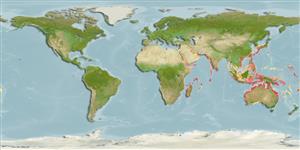分類 / Names
共通名の | 類義語 | Catalog of Fishes(部類, 種) | ITIS | CoL | WoRMS | Cloffa
>
Eupercaria/misc (Various families in series Eupercaria) >
Haemulidae (Grunts) > Plectorhinchinae
Etymology: Plectorhinchus: Greek, plektos = plaited + Greek, rhyngchos = snout (Ref. 45335).
More on author: Cuvier.
Environment: milieu / climate zone / depth range / distribution range
生態学
海 関連する礁; 深さの範囲 2 - 80 m (Ref. 90102). Tropical; 35°N - 38°S, 28°E - 172°E
Indo-West Pacific: Red Sea south to Transkei, South Africa and east to Papua New Guinea, north to southern Japan, south to western Australia and New South Wales (Ref. 9710).
Length at first maturity / サイズ / 重さ / 年齢
Maturity: Lm ?, range 34 - ? cm
Max length : 60.0 cm TL オス/雌雄の選別がない; (Ref. 2799)
背面の脊椎 (合計) : 12 - 13; 背鰭 (合計) : 19 - 22; 肛門の骨: 3; 臀鰭: 7. This species is distinguished by the following characters: chin with 6 pores, no median pit; gill rakers on first gill arch 11-14 + 1 + 16-19 = 26-34; D XII-XIII (mostly XIII),19-22, 4th or 5th spines longest; lips fleshy, moderately swollen with age; scales ctenoid (rough to touch); lateral line tubed scales about 53-60; body depth 2.5-2.8 in SL; caudal fin slightly rounded in juveniles becoming emarginate in adults. Colour of body bluish grey, juveniles with golden or rusty orange stripes along the body that break into a reticulate pattern and later form small spots that may be lost with age or remain as lines, or lines of spots on head (Ref. 47695, 90102).
Inhabits coastal inshore waters near sheltered reefs, lagoons, sandbanks and seagrass areas, solitarily or in groups (Ref. 47695, 90102). Adults usually on silty reefs at moderate depths, or in current channels occasionally inshore; juveniles enter estuaries and harbors (Ref. 48635). Feeds on small fishes and crustaceans (Ref. 5213). Taken by handline and spear. A common species marketed fresh, a small quantity is salted, good food fish (Ref. 47695). Maximum depth reported taken from Ref. 9773.
Life cycle and mating behavior
Maturities | 繁殖 | Spawnings | Egg(s) | Fecundities | 幼生
Oviparous, distinct pairing during breeding (Ref. 205).
Masuda, H., K. Amaoka, C. Araga, T. Uyeno and T. Yoshino, 1984. The fishes of the Japanese Archipelago. Vol. 1. Tokai University Press, Tokyo, Japan. 437 p. (text). (Ref. 559)
Human uses
水産業: 商業
用具
特記事項
XMLをダウンロードして下さい
インターネットの情報源
Estimates based on models
Preferred temperature (Ref.
123201): 22 - 29.1, mean 27.6 °C (based on 2161 cells).
Phylogenetic diversity index (Ref.
82804): PD
50 = 0.5000 [Uniqueness, from 0.5 = low to 2.0 = high].
Bayesian length-weight: a=0.01778 (0.01073 - 0.02948), b=3.01 (2.87 - 3.15), in cm total length, based on LWR estimates for this species & Genus-body shape (Ref.
93245).
栄養段階 (Ref.
69278): 3.8 ±0.58 se; based on food items.
回復力 (Ref.
120179): 手段, 1.4年~4.4年の倍増期間の最小個体群 (Preliminary K or Fecundity.).
Fishing Vulnerability (Ref.
59153): Moderate vulnerability (44 of 100).
Nutrients (Ref.
124155): Calcium = 30.4 [11.1, 57.1] mg/100g; Iron = 0.487 [0.256, 0.945] mg/100g; Protein = 19.6 [17.7, 21.4] %; Omega3 = 0.123 [0.066, 0.201] g/100g; Selenium = 29.4 [16.9, 50.6] μg/100g; VitaminA = 77.7 [30.5, 197.0] μg/100g; Zinc = 0.978 [0.674, 1.446] mg/100g (wet weight);
